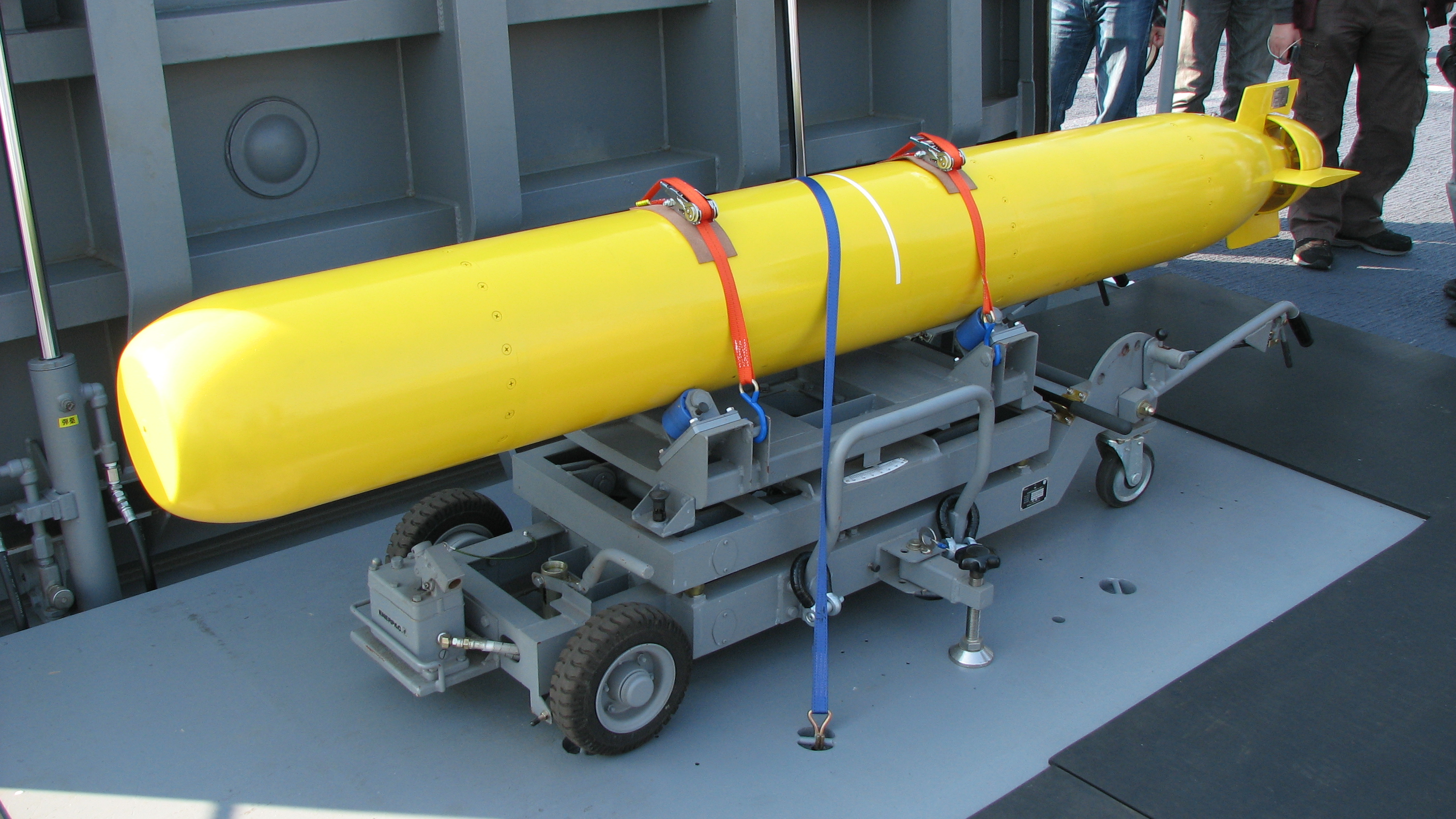|
APR-3E Torpedo
The APR-3E airborne light ASW acoustic homing torpedo is designed by Russian Tactical Missiles Corporation JSC to engage current and future submarines at depth from the surface down to 800 metres at speed of up to 43+ knots, and it is a replacement for earlier APR-2 light antisubmarine acoustic homing torpedo. APR-3E airborne light antisubmarine acoustic homing torpedo is designed to be carried by a various fixed wing and rotary wing platforms including Tu-142, Il-38, Ka-28 and other aircraft. The torpedo requires at least 100 metres depth of water for the initial air-drop and can be deployed in conditions up to sea state 6. Once entering water, the control surfaces of the torpedo enable the torpedo to travel in a spiral path with the help of gravity without starting the engine. During this stage, the acoustic seeker of the torpedo searches for targets. Once the target is identified, the engine starts and solid propellant rocket engine ensures the target has virtually very ... [...More Info...] [...Related Items...] OR: [Wikipedia] [Google] [Baidu] |
Torpedo
A modern torpedo is an underwater ranged weapon launched above or below the water surface, self-propelled towards a target, and with an explosive warhead designed to detonate either on contact with or in proximity to the target. Historically, such a device was called an automotive, automobile, locomotive, or fish torpedo; colloquially a ''fish''. The term ''torpedo'' originally applied to a variety of devices, most of which would today be called mines. From about 1900, ''torpedo'' has been used strictly to designate a self-propelled underwater explosive device. While the 19th-century battleship had evolved primarily with a view to engagements between armored warships with large-caliber guns, the invention and refinement of torpedoes from the 1860s onwards allowed small torpedo boats and other lighter surface vessels, submarines/ submersibles, even improvised fishing boats or frogmen, and later light aircraft, to destroy large ships without the need of large guns, th ... [...More Info...] [...Related Items...] OR: [Wikipedia] [Google] [Baidu] |
Ministry Of Defence (Russia)
The Ministry of Defence of the Russian Federation (russian: Министерство обороны Российской Федерации, Минобороны России, informally abbreviated as МО, МО РФ or Minoboron) is the governing body of the Russian Armed Forces. The President of Russia is the Commander-in-Chief of the Armed Forces of the Russian Federation and directs the activity of the Ministry. The Defence Minister exercises day-to-day administrative and operational authority over the armed forces. The General Staff executes the president's and the defence minister's instructions and orders. The main building of the ministry, built in the 1940s, is located on Arbatskaya Square, near Arbat Street. Other buildings of the ministry are located throughout the city of Moscow. The supreme body responsible for the Ministry's management and supervision of the Armed Forces is The National Defense Management Center (Национальный центр управл ... [...More Info...] [...Related Items...] OR: [Wikipedia] [Google] [Baidu] |
Aerial Torpedoes
Aerial may refer to: Music * ''Aerial'' (album), by Kate Bush * ''Aerials'' (song), from the album ''Toxicity'' by System of a Down Bands *Aerial (Canadian band) * Aerial (Scottish band) *Aerial (Swedish band) Performance art *Aerial silk, apparatus used in aerial acrobatics *Aerialist, an acrobat who performs in the air Recreation and sport *Aerial (dance move) *Aerial (skateboarding) * Aerial adventure park, ropes course with a recreational purpose * Aerial cartwheel (or side aerial), gymnastics move performed in acro dance and various martial arts *Aerial skiing, discipline of freestyle skiing *Front aerial, gymnastics move performed in acro dance Technology Antennas *Aerial (radio), a radio ''antenna'' or transducer that transmits or receives electromagnetic waves **Aerial (television), an over-the-air television reception antenna Mechanical *Aerial fire apparatus, for firefighting and rescue *Aerial work platform, for positioning workers Optical *Aerial ... [...More Info...] [...Related Items...] OR: [Wikipedia] [Google] [Baidu] |
Torpedoes Of Russia
A modern torpedo is an underwater ranged weapon launched above or below the water surface, self-propelled towards a target, and with an explosive warhead designed to detonate either on contact with or in proximity to the target. Historically, such a device was called an automotive, automobile, locomotive, or fish torpedo; colloquially a ''fish''. The term ''torpedo'' originally applied to a variety of devices, most of which would today be called mines. From about 1900, ''torpedo'' has been used strictly to designate a self-propelled underwater explosive device. While the 19th-century battleship had evolved primarily with a view to engagements between armored warships with large-caliber guns, the invention and refinement of torpedoes from the 1860s onwards allowed small torpedo boats and other lighter surface vessels, submarines/submersibles, even improvised fishing boats or frogmen, and later light aircraft, to destroy large ships without the need of large guns, though som ... [...More Info...] [...Related Items...] OR: [Wikipedia] [Google] [Baidu] |
Type 97 Light Weight Torpedo (G-RX4)
The Type 97 Torpedo (97式短魚雷, 97 Shiki Tan Gyorai) is a short-range torpedo developed and built by the Mitsubishi Heavy Industries for the Japanese Maritime Self Defense Force. This type of torpedo, like many other modern Japanese weapons systems, is not exported. Development At the end of the Cold War, Soviet attack submarines were capable of moving at higher speed and diving at lower depth, rendering the torpedoes used by US navy and the JMSDF, like the Mk-46 torpedo, less able to deal with them. So a new type of torpedo needed to be developed. The US launched a new type of torpedo, the Mk-50 using an infrared detector and a closed-loop pump with an integrated processing unit for analyzing underwater sound waves for target acquisition. This type of torpedo can also be used to intercept other torpedoes. Soviet submarines, however, have developed adaptive capabilities, such as the use of trap baits and interference of the detection system, making it harder for the ... [...More Info...] [...Related Items...] OR: [Wikipedia] [Google] [Baidu] |
Chung Sang Eo
The K745 Blue Shark (Hangul: 청상어 경어뢰) is a light anti-submarine torpedo developed for the Republic of Korea Navy in 2004. The Blue Shark torpedo can be deployed from surface ships, ASW helicopters and maritime patrol aircraft. Production cost for each torpedo is at about ₩ 1,000,000,000. Blue Shark torpedoes are fitted to the Incheon class frigate (FFX). An improved variant, the lightweight torpedo-2 is being developed by LIG Nex1. New capabilities include longer range and lesser vulnerability to decoys. See also * APR-3E torpedo - Russian equivalent * Mark 54 Lightweight Torpedo - US Navy's equivalent * A244-S - Italian equivalent * MU90 Impact - French/Italian equivalent * Sting Ray (torpedo) - British equivalent * TAL Shyena - Indian equivalent * Yu-7 torpedo The Yu-7 (; from ) is a lightweight torpedo developed by the People's Republic of China. It entered service in the 1990s as the principal anti-submarine weapon of major People's Liberation Army Navy ... [...More Info...] [...Related Items...] OR: [Wikipedia] [Google] [Baidu] |
Yu-7 Torpedo
The Yu-7 (; from ) is a lightweight torpedo developed by the People's Republic of China. It entered service in the 1990s as the principal anti-submarine weapon of major People's Liberation Army Navy (PLAN) warships. The Yu-7 is a derivative of the Whitehead Alenia Sistemi Subacquei (WASS) A244/S torpedo. Development Development of an effective lightweight anti-submarine (ASW) torpedo for the PLAN began in the 1980s. The program was probably based on 40 A244/S torpedoes purchased for evaluation from Italy in 1987. Additional technology may have been reverse engineered from a United States Mark 46 Mod 2 torpedo recovered from the South China Sea in 1978 by Chinese fishermen. The torpedo was initially equipped with electric propulsion, but inadequate performance led to a redesign powered by Otto fuel II. Testing was carried out at the 750 Testing Range in Kunming up to 1988. Description The Yu-7 has contrarotating propellers. Aboard surface warships, it is fired from Type 7424 tr ... [...More Info...] [...Related Items...] OR: [Wikipedia] [Google] [Baidu] |
Advanced Light Torpedo Shyena
The Advanced Light Torpedo (TAL) Shyena (Sanskrit: श्येन, "Falcon or Hawk") is the first indigenous advanced lightweight anti-submarine torpedo of India, developed by the Naval Science and Technological Laboratory (NSTL) of the Defence Research and Development Organisation (DRDO) for the Indian Navy. The lightweight torpedo can be launched by ships, submarines, helicopters and Ilyushin Il-38, named after the divine hawk identified with Agni. Introduction Shyena is a processor based torpedo which incorporates solid-state electronics, digital technology and has been equipped with an integrated Active/Passive sensor package for homing. It is designed to be capable of being launched from both a helicopter or from a triple-tube launcher on surface vessels. Its key design feature are maneuverability and ability to transition from warm to cold medium to ensure a hunt and kill. The development period of the torpedo was quite long, starting in the 1990s, and was inducted into t ... [...More Info...] [...Related Items...] OR: [Wikipedia] [Google] [Baidu] |
Sting Ray (torpedo)
The Sting Ray is a British acoustic homing lightweight torpedo (LWT) manufactured by GEC-Marconi, who were later bought out by BAE Systems. It entered service in 1983. Design and development In the 1950s the Royal Navy was equipped with British designed and built Mk 30 air-dropped torpedoes. These were passive homing weapons which relied on detecting the noise from submarine targets. However, as submarine noise levels decreased these weapons became ineffective. A design for a British Mk 31 torpedo which would have used active echo-location sonar failed to receive Government approval for production. US Mk 44 torpedoes were purchased for the Royal Navy in the 1960s to fill this role, and later replaced by US Mk 46 torpedoes. A desire not to be dependent on US torpedo purchases led to a research programme starting in 1964 to develop a British torpedo. Initially designated Naval and Air Staff Requirement (NASR) 7511, it was (much later in the late 1970s) designated the Sting ... [...More Info...] [...Related Items...] OR: [Wikipedia] [Google] [Baidu] |
Mark 54 Lightweight Torpedo
The Mark 54 Lightweight Torpedo (formerly known as Lightweight Hybrid Torpedo, or LHT) is a standard anti-submarine warfare (ASW) torpedo used by the United States Navy. Development The Mark 54 was co-developed by Raytheon Integrated Defense Systems and the U.S. Navy under the U.S. Navy's Lightweight Hybrid Torpedo program in response to perceived problems with the extant Mark 50 and Mark 46 torpedoes. The Mk 50, having been developed to counter very high performance nuclear submarines such as the Soviet Alfa class, was seen as too expensive to use against relatively slow conventional submarines. The older Mk 46, designed for open-ocean use, performed poorly in the littoral areas, where the Navy envisioned itself likely to operate in the future. The Mk 54 was created by combining the homing portion of the Mk 50 and the warhead and propulsion sections of the Mk 46, improved for better performance in shallow water, and with the addition of commercial off-the-shelf (COT ... [...More Info...] [...Related Items...] OR: [Wikipedia] [Google] [Baidu] |
A244-S
The A244-s is an Italian lightweight, fire-and-forget torpedo employed for anti-submarine warfare. It can be launched from surface vessels or from aircraft, and locates the target by means of an acoustic seeker. Description The torpedo uses a CIACIO-S seeker, consisting of an acoustic homing head containing the transducer assembly, transmitter and related Beamforming circuits, and a frame housing all the remaining electronic components. The homing head is capable of active, passive or mixed modes for closing onto its target. It can also discriminate between decoys and real targets in the presence of heavy reverberations by specially emitted pulses and signal processing. The latest version is the A244-S mod.3 torpedo. The A244/s are developed and manufactured by the Italian WASS (Whitehead Alenia Sistemi Subacquei) firm. Operators Current operators * - 25 ordered in 2011 * - 540 * * - 50 (ET52 torpedo) The ET52 is the Chinese development of the Italian Alenia A244 ... [...More Info...] [...Related Items...] OR: [Wikipedia] [Google] [Baidu] |






